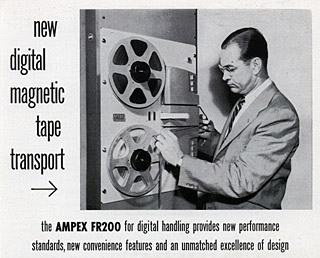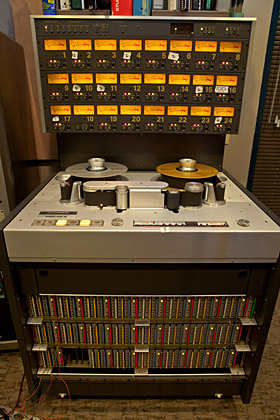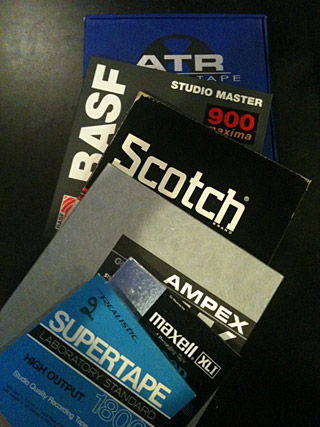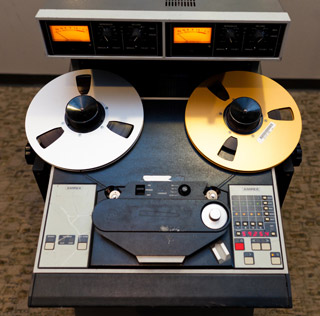08 Sep Analog Tape Recording Basics
No, I haven’t gone “crazy”. I used to have a real, analog (real tape) Studer A800, but it was hard (difficult) to use.
Today, we have (and we’ll keep on having in the future) the option of the “emulations”. One emulation I am really using extensively right now is the Studer A800 tape recording.
It’s provided in fact by Universal Audio, and it is the one I know that several professionals are also using currently. I use it for everything AC/DC related, since AC/DC recorded onto tape at least until the mid 1990s (definitely so on every early record, including Back in Black). It really adds something special, as a finishing touch.
You can see here what I used (and use regularly) recently to simulate the several aspects of a recording studio. Most of the plugins I use are from Universal Audio UAD 2
I am copying and pasting this directly from Universal Audio:
—-
- If you’re looking for a prime example of what Toffler wrote about in Future Shock, look no further than analog tape. In little more than a decade, the two-inch multitrack tape machine has gone from studio staple to relic rarity. And while many audio veterans wax nostalgic for that warm analog sound, few will admit to missing the work that went with it.
These days, owning an analog tape machine is somewhat akin to driving a classic car, with ongoing maintenance, scarcity of parts, and exotic fuel (analog tape) that’s expensive and hard to find. So while a handful of top studios still offer those classic spinning reels (and the engineers to maintain them), the good news for the rest of us is that there are now more convenient ways to achieve that classic magnetic sound.

A Bit of History
Analog recording, of course, predates tape — with everything from wax cylinders to wire being used to capture a performance. But when American audio engineer Jack Mullin discovered a pair of German Magnetophon machines during World War II, he knew right away he was on to something big. The format offered two major advantages over the acetate disks of the day: a recording time of more than 30 minutes, and the ability for recordings to be edited. It was the first time audio could be manipulated.
Mullin brought the two Magnetophons back home after the war and demonstrated them for Bing Crosby at MGM Studios in 1947. Crosby immediately saw the potential for prerecording his radio shows, and invested a small fortune of $50,000 in a local electronics company called Ampex to develop a production model.
Ampex and Mullen soon followed with commercial grade recorders. One of the first Ampex Model 200 recorders was given to guitarist Les Paul, who took the concept of audio manipulation to a higher level. Paul had already been experimenting with overdubbed recording on disks and, quickly realizing the potential for adding more channels and additional recording and playback heads, came to Ampex with the idea for the first multi-track tape recorders.
The format evolved from two tracks to three and four, and although Ampex built some of the first eight-track machines in in the late 1950s, most commercially available machines were limited to four tracks until 1966, when Abbey Road recording engineers Geoff Emerick and Ken Townshend began experimenting with multiple machines during the recording of Sgt. Pepper’s Lonely Hearts Club Band.
Ampex responded to the demand the following year, introducing the revolutionary MM-1000, which recorded eight tracks on one-inch tape. Scully also introduced a 12-track one-inch design that year, but it was quickly overshadowed by a 16-track version of the MM-1000, using two-inch tape. MCI followed in 1968 with 24 tracks on two-inch tape, and the two-inch 24-track became the most common format in professional recording studios throughout most of the 1970s and 1980s.
With the prevalence of home and project studios and digital technology in the late 1980s and 1990s, a number of other tape formats emerged, including various multitrack on-reel and cassette configurations as well as multiple digital tape formats. But for the sake of this article, we’ll focus mainly on multitrack analog tape, the most sonically revered recording medium of all time.

records up to 24 tracks of audio.
How A Tape Machine Works
In the simplest of terms, magnetic tape consists of a thin layer of Mylar or similar material coated with iron oxide. The tape machine head exerts a charge on the oxide, which polarizes the oxide particles and effectively “captures” the signal. It’s a process that creates some interesting byproducts, many of which directly influence the sound of the recording.
Probably the most commonly cited chracteristic of analog recording is its “warmth.” Tape warmth adds a level of color to the sound, primarily softening the attacks of musical notes, and thickening up the low frequency range. Recording at slightly hot levels to analog tape can also produce a nice distortion that works well with certain types of music such as rock, soul, and blues.
As multitrack recording evolved, a number of different manufacturers began to emerge. By the early 1980s, Ampex was no longer the dominant multitrack manufacturer, facing stiff competition from MCI, Studer, 3M, and Otari. Although a handful of smaller manufacturers, including Stephens, Aces, and a few others also entered the fray, Ampex, Studer, 3M, MCI (later owned by Sony), and Otari became the dominant brands. Each of these manufacturers’ different models became loved (or despised) for their mechanical attributes and characteristic sound. In the day, a recording studio’s model of multitrack tape recorder was considered as intrinsic to its sound as their acoustics, console or microphone collection.

the tonal color of a recording.
The Subtle Differences
A multitude of factors influence each machine’s characteristic sound, beginning with the tape heads, amplifiers, and other electronics. Beyond that, other factors have a bearing on the sound of an analog recording, some of which are unique to each particular machine. Variations in the machine’s speed stability (wow and flutter), alignment of the tape heads and the angle of the tape, condition of the heads (cleanliness, magnetization, etc), tape tension, and other physical factors are just a few things that can affects the sound of a recording.
Besides the machine itself, other factors can affect the particular sound of an analog recording, including the brand of tape used. Back in the heyday of analog, the major brands of tape each had their supporters and detractors. Ampex tape was one of the leading brands, with their 456 formula being the most prominent. Other popular brands included AGFA and 3M. Each tape formulation imparted its own subtle sound to a recording, and each machine had to be realigned each time a brand was changed. Some studios made a policy of sticking to one brand of tape, but it was not uncommon for variations to occur even within different batches of the same brand of tape.
Tape speed is another major factor. Faster tape speeds tend to deliver cleaner sound quality, since the signal is spread over a larger area and the signal-to-noise ratio is increased. The most commonly used speeds with two-inch tape are 15 and 30 IPS (inches per second). Although 30 IPS delivers better overall sound quality, most pros agree that lower frequencies sound better at 15 IPS. Indeed, in the modern era, when tape is most often being used for its sonic effect, slower speeds prevail.

ultimate tape machine for final mastering.
Getting that Analog Tape Sound
Although owning a classic two-inch Studer or Ampex tape machine certainly earns bragging rights, in today’s DAW-oriented world, the fact is that fewer of us would opt to record to analog tape, even if we could. Space considerations, cost considerations, and the scarcity of tape and parts are only the beginning.
The fact is, tape’s destructive editing can be a slow and tedious process in a world where time is truly money. And even the medium itself is no longer cost effective. A single reel of two-inch tape averages around $200. At 15 IPS, that tape holds around 30 minutes of 24-track recording time (half that at 30 IPS). Compare that to a 2TB hard disk, currently selling for just over $100, that can hold many hours of multitrack audio, and you can see why running tape for every project is not an option for most of us.
Fortunately there are a number of great sounding plug-in processors for your DAW that can bring some of that analog tape warmth and “glue” to your tracks. For example, Universal Audio’s wildly popular Studer A800 Multichannel Tape Recorder is a stunningly faithful emulation of the original machine’s sound, having been painstakingly developed over a one year period with input from the original manufacturer. In fact, the sonic differences between the A800 plug-in and the original A800 hardware are so minute, that many of the world’s top engineers opt to use the plug-in for their day-to-day work.
Aside from the obvious convenience factor, one of the biggest advantages of tape emulation plug-ins are their flexibility. You can choose to process only certain tracks, rather than the whole mix — imparting the warmth, low-end bump, and cohesive properties of tape to the drums and bass tracks, for example, without adding any tape color to guitars and vocals. Or you can add just a hint of tape compression to the mix, without oversaturating things the way an actual two-track machine might.
Regardless of how you choose to implement it, the sound of analog tape can be a great addition to your digital mix. Take a UAD tape emulation plug-in like the Studer A800 and test it on a few tracks. You might find it’s just the thing to add a bit of nice, understated warmth, cohesiveness and punch to your mix. Tape lives on.




adam10603
Posted at 23:33h, 09 SeptemberFil, do you have any info on what exact type of tape recorder did AC/DC use in the studio? Is it the A800? Or you just picked that plugin because you already had that one in real life?
SoloDallas
Posted at 23:36h, 09 SeptemberIt’s documented here in several parts, for Back in Black (and likely Flick of The Switch) they used an MCI JH 114-24 tape machine for tracking (i.e., recording). Another one for mastering (unknown). You have to keep in mind that back then, there were NO hard disks! It was all tape. There were great tape machines. I took the A800 as is likely the most serious simulation and the easiest to get results out of.
headwhop26
Posted at 14:56h, 09 SeptemberThis is very well-timed 🙂 A friend of mine and I were just talking about the Foo Fighters recording all of Wasting Light to tape. I wish I could experiment with some of this myself and see what I can get.
Sometimes I feel bad when im “faking” all of it. The vintage sound, amp modelers, all that. Maybe this article could help. This is what I mean:
http://www.youtube.com/watch?v=uLcqsfXpthU
Thats the afore mentioned friend on the drums, me on guitar. Trying to get a Black Keys sort of sound, but we had to fake all of it 🙂 Maybe I’ll look into one of these
Ant
Posted at 14:22h, 09 SeptemberYay! A Fil update 🙂
I have a 4 track tape recorder at me mum n dads house, used once lol
cant wait to see the new vids and hear the sound of that Vega replica 😀
http://www.solodallas.com….. Cool!
Ant
SoloDallas
Posted at 14:30h, 09 SeptemberYeah, been there (real tape). A mess.
Much better to go into simulations. I think these simulations will deliver incredible results as time goes by.
ar2619Rob
Posted at 12:36h, 09 SeptemberGreat article. This is a subject that I know very little about but plan to study to some extent in the future.
More please….
SoloDallas
Posted at 12:45h, 09 SeptemberSir yes Sir. It is important, especially for us classic rock fans, because the sound of the recordings – all of them, live or in the studio – of back then, always happened on tape (now rarely).
Tape DOES things to the “sound”. It compresses it and may add tape distortion. Naturally I am talking about the fat two inch tape, not the commercial tape available to all of us. The professional tape recording machines tape. The Studer A800 plugin really is a great tool. I strongly believe that – for example – on Back in Black, tape played a big part of the overall sound. I *think* that the tape machine was used both for recording and mixing purposes (two different tape machines were used at different times) with specific tweaks (BIAS, etc.).
nitroangus23
Posted at 23:05h, 08 SeptemberFil is alive!!
lol Happy to hear from you man,
Great article,very interesting!
SoloDallas
Posted at 23:07h, 08 SeptemberOh my dear Cody, not only alive, but… kicking!
Been silent for all of this time for a reason… preparing everything for the new “season” 😀 hehehehe.
Replica is being built (prototype) have some news but kept everything quite during the summer time. Summer time is made to lay out in the sun, not to read a boring blog 😛
Anyway, will come back fully soon!
Love,
Fil
rpatzelt
Posted at 07:59h, 09 SeptemberBoring blog, huh!? 🙂 Welcome back fratello!
I can’t wait to see what we’ll get in the “new season”…
SoloDallas
Posted at 11:50h, 09 SeptemberWell you know I never liked secrets and/or mysteries, so here it is summarized up:
– More videos and tutorials but THIS time, with actual sound (i.e., using the actual equipment such as amp, cabinet, guitar, Schaffer Vega Diversity and/or its replica, microphone(s), etc.)
– The Replica. The Schaffer Vega Diversity Replica, that is. This will be the season/year of the delivery.
– SoloDallas.com (yes, not SoloDallas.net, but SoloDallas.com) and increased visibility to the world
There. Maybe nothing “incredible” or revolutionary, but the steady growth of activities that I was hoping for is actually “happening”.
All for now, over, Fil 🙂
SoloDallas
Posted at 12:28h, 09 SeptemberBasically, what held me back these last few months from releasing more tutorials was a two fold reason:
– I really always wanted to “nail” 99% of the actual tone – AC/DC-wise – of the original recordings, even on the tutorials
– I was/am very busy with the Schaffer Diversity System. At the lab, extensive testing, fixing is being done on all the Schaffer Vega systems in my possession. Additionally, I am having the chance to also fix/set optimally my Cetec Vegas, that continue to be a good alternative to the original and virtually disappeared Schaffer Vega Diversity.
The inner workings of these systems in fact are allowing us to reverse-engineer properly the signal path – the audio signal path – of the guitar in them, thus allowing us to – hopefully – perfectly replicate both the compression AND clean boost that the units put out.
adam10603
Posted at 22:54h, 08 SeptemberI’m starting to get interested in a professional quality tape simulation. I already have a tape simulation plugin, but it’s not the best one. However, I still use it very often. It just adds something special to the sound 🙂
adam10603
Posted at 22:57h, 08 SeptemberI already thought of getting a real tape recorder. The way I would use it is that it would record the sound directly from the mic (or from the mixer, if I have multiple mics), then I play back the recorded thing on the tape recorder, and record it again through my audio interface (in digital form). From then on, I can work with it on my computer, but it will already have a real tape-colored sound to it 🙂 Not a bad idea, I guess
SoloDallas
Posted at 11:52h, 09 SeptemberI would never suggest a real tape recorder now. Unless it’s a two inch tape, the effect you get is nothing close to the real deal of the good, famous ones.
I suggest you move towards the simulated ones, they are increasingly good and more and more indistinguishable from the real deal. Used by several professionals in the field – some of which high profile sound engineers/producers – these things deliver really good results.